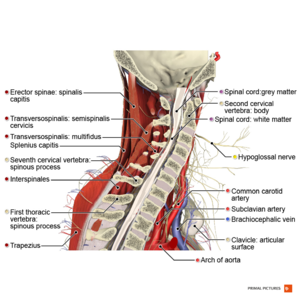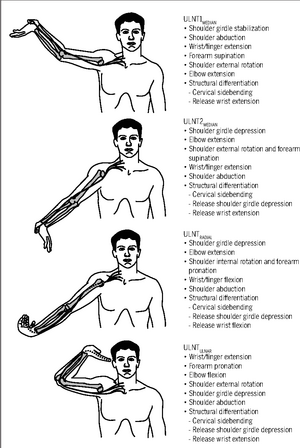Upper Limb Tension Tests (ULTTs)
Original Editor - Jennifer Self
Top Contributors - Kim Jackson, Admin, Adrianna Simmons, Jennifer Self, Hetvi Gala, Evan Thomas, Aminat Abolade, Cindy John-Chu, Jeannine Escobar, Johnathan Fahrner, WikiSysop, Claire Knott and Lucinda hampton
Edited April 2022 - by Adrianna Simmons and Jeannine Escobar as part of the Arkansas Colleges of Health Education School of Physical Therapy Musculoskeletal 1 ProjectIntroduction[edit | edit source]
The Brachial Plexus Tension or Elvey Test, also known as Upper Limb Tension Tests,[1] are designed to put stress on neurological structures of upper limb by elongating them. These tests were first described by Elvey[2] and hence also known as Elvey test but most commonly called ULTT. The ULTT's are equivalent to the straight leg raise designed for the lumbar spine.
Purpose[edit | edit source]
ULTT are performed to assess peripheral nerve mobility and compression or as a part of neurodynamic assessment. These tests are performed as a cluster to make a confirmatory diagnosis for nerve involvement. They are both diagnostic and therapeutic. Once the diagnosis is made the tests are done to mobilize the entrapped nerve.
Technique[edit | edit source]
ULTTs aim at evoking the patients symptoms. This is done by keeping the shoulder, elbow, forearm, wrist and fingers in specific positions to put stress on a particular nerve (nerve bias),[3]which can also be done with modifications in the position of each joint as a "sensitizer" to the specific nerves.[4]
General points that need to be kept in mind while performing the test.[5]
- Therapist should briefly explain the patient the procedure they are going to perform in layman terms. This decreases the feeling of anticipation among the patient and they are more calm and relaxed. Inform the patient that it may or may not evoke the symptoms and to communicate verbally when patient feels any kind of discomfort.
- Care should be taken to just evoke the symptoms and not further aggravate the symptoms.
- Each test is done on the normal/asymptomatic side first.
- The precision of the test is attributed to performance with an appropriate stabilizing hand and a slow, steady mobilizing hand.
- The final movement should not be held for more than 10 secs.
- Watch for unwanted movements which might alter the results. Traditionally for the upper limb, the order of joint positioning is shoulder followed by forearm, wrist, fingers, and lastly elbow. Each joint positioning component is added until the pain is provoked or symptoms are reproduced. To further sensitize the upper limb tests, side flexion of cervical spine can be added[4]. If pain is provoked in the very initial position, then there is no need to add further sensitizers.
Positive Test[edit | edit source]
The test is positive if one or more of the following occurs:
- Symptoms reproduced
- Side to side difference in elbow extension greater than 10 degrees
- Contralateral cervical side bending increases symptoms, or ipsilateral side bending decreases symptoms
Upper Limb Tension Test 1 (ULTT1, Median nerve bias, Magee-ULTT1)[edit | edit source]
Indications-[edit | edit source]
Movements performed[edit | edit source]
Structural differentiation[edit | edit source]
|
[6] |
Upper Limb Tension Test 2A (ULTT2A, Median nerve bias, Magee-ULTT2)[edit | edit source]
Indications[edit | edit source]
Movements performed[edit | edit source]
Structural differentiation[edit | edit source]
|
[7] |
Upper Limb Tension Test 2B (ULTT2B, Radial nerve bias, Magee-ULTT3)[edit | edit source]
Indications-[edit | edit source]
Movements performed[edit | edit source]
Structural differentiation[edit | edit source]
|
[8] |
Upper Limb Tension Test 3 (ULTT3, Ulnar nerve bias, Magee-ULTT4)[edit | edit source]
Indications[edit | edit source]
Movements performed[edit | edit source]
Structural Differentiation[edit | edit source]
|
[9] |
Magee Orthopedic Physical Assessment ULTT Description[edit | edit source]
The 7th edition of Orthopedic Physical Assessment by David Magee, published by Elsevier in 2020, uses an updated method from Elvey to label the ULTTs. Magee describes the tests as ULTT1,2,3, and 4, respectively rather than the more widely used ULTT1, 2a, 2b, and 3. Magee also recognizes ULTT2 as being able to test for musculocutaneous and axillary nerve involvement[10].
Normal (negative) Symptoms[10]:
• Deep ache or stretch in cubital fossa (99%)
• Deep ache or stretch into anterior and radial aspect of forearm and radial aspect of hand (80%)
• Tingling to the fingers supplied by appropriate nerve (nerve bias)
• Stretch in anterior shoulder area
• Above responses increased with contralateral cervical side flexion (90%)
• Above responses decreased with ipsilateral cervical side flexion (70%)
Evidence[edit | edit source]
Diagnostic Accuracy[11]
Reference standard cervical radiculopathy as diagnosed by needle electromyography and nerve conduction studies.
Sensitivity= .50
Specificity= .86
-LR= .58
+LR= 3.5
Reliability
Inter-examiner Kappa= .76
According to this study the ULTTs have moderate to substantial reliability.[12]
Resources[edit | edit source]
For more information visit this Physiopedia page Neurodynamic Assessment
References[edit | edit source]
- ↑ Magee DJ.Orthopaedic physical assessment.5th edition.Elsevier publication.
- ↑ Elvey RL: The investigation of arm pain. In Boyling JD, Palastanga N (eds): Grieve’s modern manual therapy: the vertebral column, 2nd ed. Edinburgh, 1994, Churchill Livingstone.
- ↑ Butler DS: Mobilisation of the nervous system, Melbourne, 1991, Churchill Livingstone.
- ↑ Flynn TW, Cleland JA, Whitman JM. Users' Guide To The Musculoskeletal Examination. Evidence in Motion; 2008.
- ↑ 5.0 5.1 5.2 5.3 5.4 Shacklock M. Clinical neurodynamics: a new system of neuromusculoskeletal treatment. Elsevier Health Sciences; 2005 May 6.
- ↑ Adrianna Simmons. Upper Limb Tension Test 1. Available from: https://www.youtube.com/watch?v=Cy6kqiLLDII [last accessed 14/4/2022]
- ↑ Adrianna Simmons. Upper Limb Tension Test 2A. Available from: https://www.youtube.com/watch?v=kcTN1Tmp-Zg [last accessed 14/4/2022]
- ↑ Adrianna Simmons. Upper Limb Tension Test 2B. Available from: https://www.youtube.com/watch?v=b5VkzZ06vW4 [last accessed 14/4/2022]
- ↑ Adrianna Simmons. Upper Limb Tension Test 3. Available from: https://www.youtube.com/watch?v=dogBcKQ1y88 [last accessed 14/4/2022]
- ↑ 10.0 10.1 Magee DJ, Manske RC. Orthopedic physical assessment. 7th ed. Philadelphia, PA: Saunders; 2021.
- ↑ Hartley A. Practical Joint Assessment. St Louis: Mosby; 1995.
- ↑ Schmid AB, Brunner F, Luomajoki H, Held U, Bachmann LM, Künzer S, Coppieters MW. Reliability of clinical tests to evaluate nerve function and mechanosensitivity of the upper limb peripheral nervous system. BMC musculoskeletal disorders. 2009 Dec;10(1):1-9.








